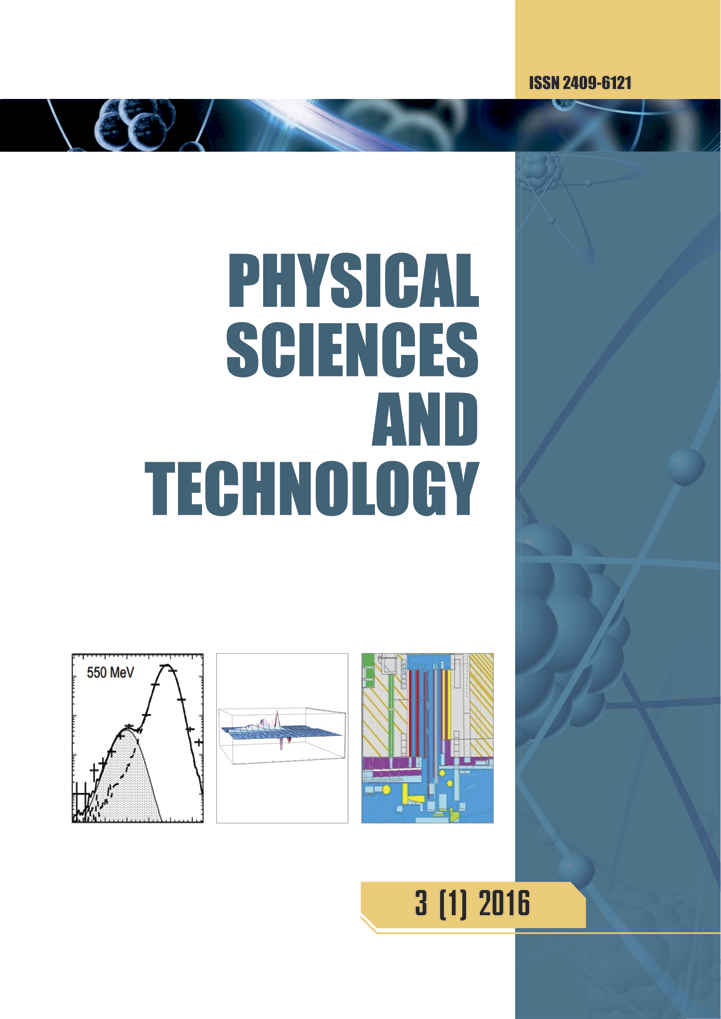Electrons energy distribution in helium plasma, generated by fission fragments
100 0
Keywords:
Monte Carlo method, energy distribution, excites atoms, electron ionization, cross section. PACS numbers, 52.70.-m, 52.20Abstract
The problem of ionization and excitation pair prices in any gas medium can be solved by modeling the process of exchanging energy of the primary electrons with neutrals by Monte Carlo technique. The advantage of this method is that the physical processes of individual collisions of electrons are associated with a direct statistical analogy – branching random walk of a particle in a one–dimensional phase space. In this case, the transition probabilities are determined by the relevant integral cross sections of the processes of electron interactions with neutrals. This method allows a more complete analysis of the process, calculating as an average values of the characteristics of the interaction, and the time evolution of the electrons energy distribution.References
[1] Tomizo I., Toshimitsu M. Monter Carlo Calculations of motion of electrons in Helium // Journal of the Physical Society of Japan. – 1960. – Vol.15. – N0.9. – P.1675–1680.
[2] Benjamin S.W., Geoge H.M. Monte Carlo simulations of Radiation–Induced Plasmas // Nuclear Science and Engineering. – 1973. – Vol.52. – P.130–141.
[3] Leffert C.B., Reese D.B., Jamerson F.E. Noble Gas Plasmas Produced by Fission Fragments // J.Appl.Phys. – 1966. – Vol.37. –P.133–142.
[4] Nguyen D.H., Grossmsan L.M. Ionization by Fission Fragments Escaping from Source Medium // Nucl.Sci. and Engin. – 1967. – Vol.30. – P.233–241.
[5] Guyot J.C., Miley G.H., Verdeyen J.T. Application of a Two Region Heavy Charged Particle Model to Noble Gas Plasmas Induced by Nuclear Radiation // Nucl.Sci. and Engin. – 1972. – Vol.48. – P.372–386.
[6] Konovalov V.P., Son E.E. Degradacionnye spektry elektronov v gazax. ximiya plazmy. – М.: Ener–goatomizdat, 1987.
[7] Smirnov B.M. Atomnye stolknoveniya I elementarnye processy v plazme. – M.: Atomizdat, 1968.
[8] Kunakov S.K., Son E.E. Probe Diagnostics of Nuclear Excited Plasma of Uranium Hexafluoride // High Temperature. – 2010. – Vol.48. – N. 6. – P.789-805.
[9] KunakovS.K. Eksperimentalnaya ustanovka dlya izmereniya bsolyutnyx intensivnostej spektralnyx linij opticheskogo izlucheniya plazmy gazovyx smesej, obrazovannyx v aktivnoj zone stacionarnogo yadernogo reaktora // Zhurnal problem evolyucii otkrytyx system. –
2010. – Vol. 1. – N. 12. – P.32-38.
[10] Kunakov S.K., Redkin A.V. Studies of the luminescent characteristics of helium mercury mixture excited by a nuclear reactor // Journal of Applied Spectroscopy. – 1990. – Vol.52. – N. 2. – P.221-225.
[11] Lakoba I.S., Yakovlenko S.I. Aktivnye sredy kompleksnyx lazerov. // Obzor. Kvantovaya elektronika.– 1980. – Vol.7. – N. 4. – P.1140-1176.
[12] Michal G. Classical Theory of Atomic Collissions. // I. Theory of nelastic Collisions, Physical Review. – 196 5. – Vol.138. – N. 2A. – P. 336-358.
[2] Benjamin S.W., Geoge H.M. Monte Carlo simulations of Radiation–Induced Plasmas // Nuclear Science and Engineering. – 1973. – Vol.52. – P.130–141.
[3] Leffert C.B., Reese D.B., Jamerson F.E. Noble Gas Plasmas Produced by Fission Fragments // J.Appl.Phys. – 1966. – Vol.37. –P.133–142.
[4] Nguyen D.H., Grossmsan L.M. Ionization by Fission Fragments Escaping from Source Medium // Nucl.Sci. and Engin. – 1967. – Vol.30. – P.233–241.
[5] Guyot J.C., Miley G.H., Verdeyen J.T. Application of a Two Region Heavy Charged Particle Model to Noble Gas Plasmas Induced by Nuclear Radiation // Nucl.Sci. and Engin. – 1972. – Vol.48. – P.372–386.
[6] Konovalov V.P., Son E.E. Degradacionnye spektry elektronov v gazax. ximiya plazmy. – М.: Ener–goatomizdat, 1987.
[7] Smirnov B.M. Atomnye stolknoveniya I elementarnye processy v plazme. – M.: Atomizdat, 1968.
[8] Kunakov S.K., Son E.E. Probe Diagnostics of Nuclear Excited Plasma of Uranium Hexafluoride // High Temperature. – 2010. – Vol.48. – N. 6. – P.789-805.
[9] KunakovS.K. Eksperimentalnaya ustanovka dlya izmereniya bsolyutnyx intensivnostej spektralnyx linij opticheskogo izlucheniya plazmy gazovyx smesej, obrazovannyx v aktivnoj zone stacionarnogo yadernogo reaktora // Zhurnal problem evolyucii otkrytyx system. –
2010. – Vol. 1. – N. 12. – P.32-38.
[10] Kunakov S.K., Redkin A.V. Studies of the luminescent characteristics of helium mercury mixture excited by a nuclear reactor // Journal of Applied Spectroscopy. – 1990. – Vol.52. – N. 2. – P.221-225.
[11] Lakoba I.S., Yakovlenko S.I. Aktivnye sredy kompleksnyx lazerov. // Obzor. Kvantovaya elektronika.– 1980. – Vol.7. – N. 4. – P.1140-1176.
[12] Michal G. Classical Theory of Atomic Collissions. // I. Theory of nelastic Collisions, Physical Review. – 196 5. – Vol.138. – N. 2A. – P. 336-358.
Downloads
How to Cite
Kunakov, S., Son, E., & Bolatov, Z. (2015). Electrons energy distribution in helium plasma, generated by fission fragments. Physical Sciences and Technology, 1(2). Retrieved from https://phst.kaznu.kz/index.php/journal/article/view/47
Issue
Section
Plasma Physics and Related Technology




